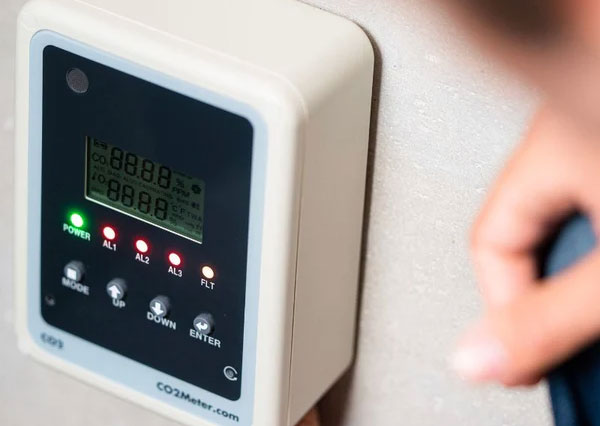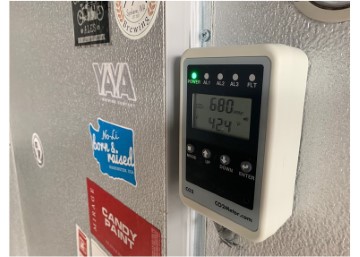oxygen safety alarm
a wall-mounted alarm for monitoring oxygen or nitrogen in the workplace
overview
 The Oxygen Safety Alarm is the product that is required by workplaces where low or excessive levels of oxygen are a safety hazard.
The Oxygen Safety Alarm is the product that is required by workplaces where low or excessive levels of oxygen are a safety hazard.
- Calibrated, easy to install, low maintenance and low cost.
- Ideal where nitrogen cylinders are used in the workplace.
- Comply with workplace safety standards AS5034-2005
- Audible and Visual Alarms
The ESRAD-002 Oxygen Safety Alarm is designed to protect you and your staff when oxygen levels may become depleted.
Complying with workplace safety standard AS5034-2005 requires workplaces to install a CO2 and/or O2 safety alarm where CO2 gas cylinders, or N2 gas cylinders, are stored in an enclosed environment. For CO2 monitoring, the ESRAD-102 model is required.
The Oxygen Safety Alarm is designed to protect customers and workers near stored inert gases like Nitrogen, Argon, and others. Low oxygen alarms are critical in cryogenics, cryotherapy, food production facilities, process cooling, or in any enclosed space where inert gases are stored.
The Monitor has both audible and visual alarms. 2 built-in relays can trigger the alarms at different user-defined O2 levels (depleted or elevated), as well as control a ventilation fan or an HVAC control switch to notify maintenance staff of low or high O2 levels.
The Oxygen Safety Alarm is easy to install and use. Mount both units on the wall (all cables and hardware included), plug the display unit into a standard wall jack, and the alarms are ready to protect you, your family and your employees.
models:
- ESRAD-002: suitable in locations where oxygen may become low or depleted.
features
- The sensor connects with Remote Display Unit using an 8m RJ45 cable (included)
- A large digital LCD display clearly indicates the current O2 level and temperature
- Optional strobe lights w 2m cables for additional visual notification of alarm
- 2 relays to control ventilation fan(s) or provide remote monitoring
- Built-in 80dB audible and visual alarm indications
- IP54 Enclosure - prevents water damage during wash-down
installation tips
Properly placing carbon dioxide gas monitoring alarms during installation cannot be underestimated. Serious thought should be put into planning the placement, electrical wiring, and careful protection of devices as well as how to train employees about the devices and what to do if they go off. In every instance, a risk assessment is the initial key to safety.
There are two parts to every oxygen monitor and safety alarm:
- Oxygen sensor
- Remote display
Note that while both of these devices include audible and visual alarms, they need to be installed differently.
installing the oxygen safety alarm
Your site assessment should consider four factors to ensure the proper installation of the systems.
Prior to your site assessment, we recommend that you inquire about and understand the local and state codes that may now require specific additions to monitors.
Adding strobe lights for additional visual notification is the most common addition. Meeting these new requirements is not optional; You will be fined if these requirements are not met.
installing the oxygen remote display
 The remote display is a critical feature of the Oxygen Safety Alarm unit. The remote display allows staff and team members to see the oxygen levels inside an enclosed space (i.e. laboratory or storage area) before they enter that space. The remote display is critical to know whether or not the enclosed space is safe.
The remote display is a critical feature of the Oxygen Safety Alarm unit. The remote display allows staff and team members to see the oxygen levels inside an enclosed space (i.e. laboratory or storage area) before they enter that space. The remote display is critical to know whether or not the enclosed space is safe.
Both the oxygen sensor unit and remote display unit have audible and visual alarms. However, while the oxygen sensor monitors in an enclosed area where oxygen could become low or too high, the remote display is designed to be mounted outside the space and to warn staff of a potential gas leak before entering the area.
Remote displays are best mounted at eye level near the door frame of any door entering the enclosed area. Additionally, they should be mounted on the same side as the door handle to ensure they are not covered when the door is open.
Our Oxygen Safety Monitors have the ability to daisy-chain up to 3 remote displays to a single oxygen sensor unit. So, if there are more than three entry doors, a second oxygen sensor unit will be required.
safety signage
Once the Oxygen Sensor Unit and Remote Display(s) are installed, you should also install safety signage at every door. The signage should be visible whether the door is opened or closed. All our Oxygen Safety Monitors come with the necessary safety signage.
Note that the suggestions above are best practices gained from experience but are not an endorsement of any specific location in your building. Every installation is different. If you have questions about your installation, contact your local building inspector.
specifications
manual & docs
ESRAD-002 Oxygen Safety Alarm for Depleted Levels
related products










